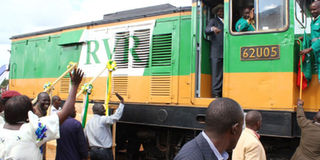RVR invests Shs10 billion in locomotive expansion

President Museveni (inside wagon) commissions a Rift Valley Railways wagon recently. The railway operator has invested Shs10 billion to double its locomotive and wagon fleet. File Photo.
What you need to know:
RVR shareholders have injected overShss392 billion to improve infrastructure.
Regional railway operator Rift Valley Railways (RVR) has invested $4 million (about Shs10 billion) in an ambitious programme to double its locomotive and wagon fleet by the end of June next year.
RVR announced yesterday that 20 locomotives had been purchased in the new programme to double haulage capacity in the next eight months.
Commenting on the new development, the RVR group chief executive officer, Mr Darlan De David, noted that since 2010, RVR shareholders have injected over $156 million (about Shs392 billion) to improve railway infrastructure and install modern, GPS-based train management technology in Kenya and Uganda.
“Investing in expanding our cargo haulage capacity to meet growing demand is the logical next step in our plans,” he said.
The trains are equipped with a microprocessor control system that monitors the engine’s performance and boosts load-carrying capacity by 20 per cent by optimising the traction between the wheels and the railway track.
The 12-cylinder, turbocharged engines are built by American industrial conglomerate General Electric, and will be delivered between March and the end of June next year.
RVR recently rebuilt 73km of rail track between Nairobi and Mombasa and nine culverts between Busembatia and Jinja, helping cut cargo transit time to Uganda by six hours.
The company has also rehabilitated and reopened the 500km Tororo-Gulu-Pakwach railway line in northern Uganda, to facilitate delivery of rail cargo from Gulu by road to South Sudan and eastern DR Congo.
Mr Cosma Gatere, the RVR director of external affairs, said the company is also making an extra investment of $2 million (about Shs5b) to purchase seven engines from General Electric, which will be used to power locomotives that can be locally assembled in Kenya.
“On top of this investment RVR is making an extra investment of $2.4 million by the end of January to purchase automated railway line maintenance machines, which will be used to correct the railway line geometry at a rate of 1 kilometer per hour,” he said.
“By the end of February, RVR will import a train simulator worth $750, which will be used to train RVR drivers across the region,” he added.
Mr De David was optimistic that, the added capacity expansion will dramatically increase rail cargo carrying ability which will be a bonus to freight transporters not only in Kenya and Uganda, but across East Africa.
Transport minister Abraham Byandala was unable to respond to our calls about the developments by press time.




